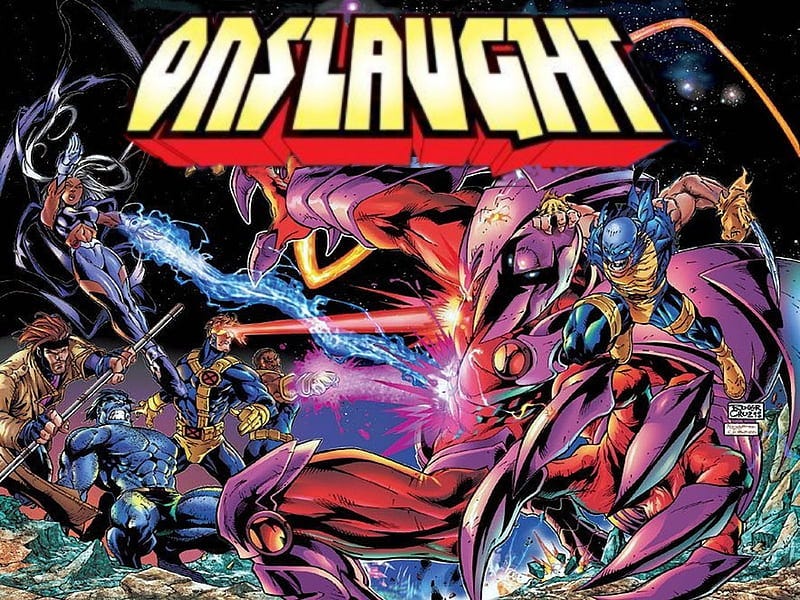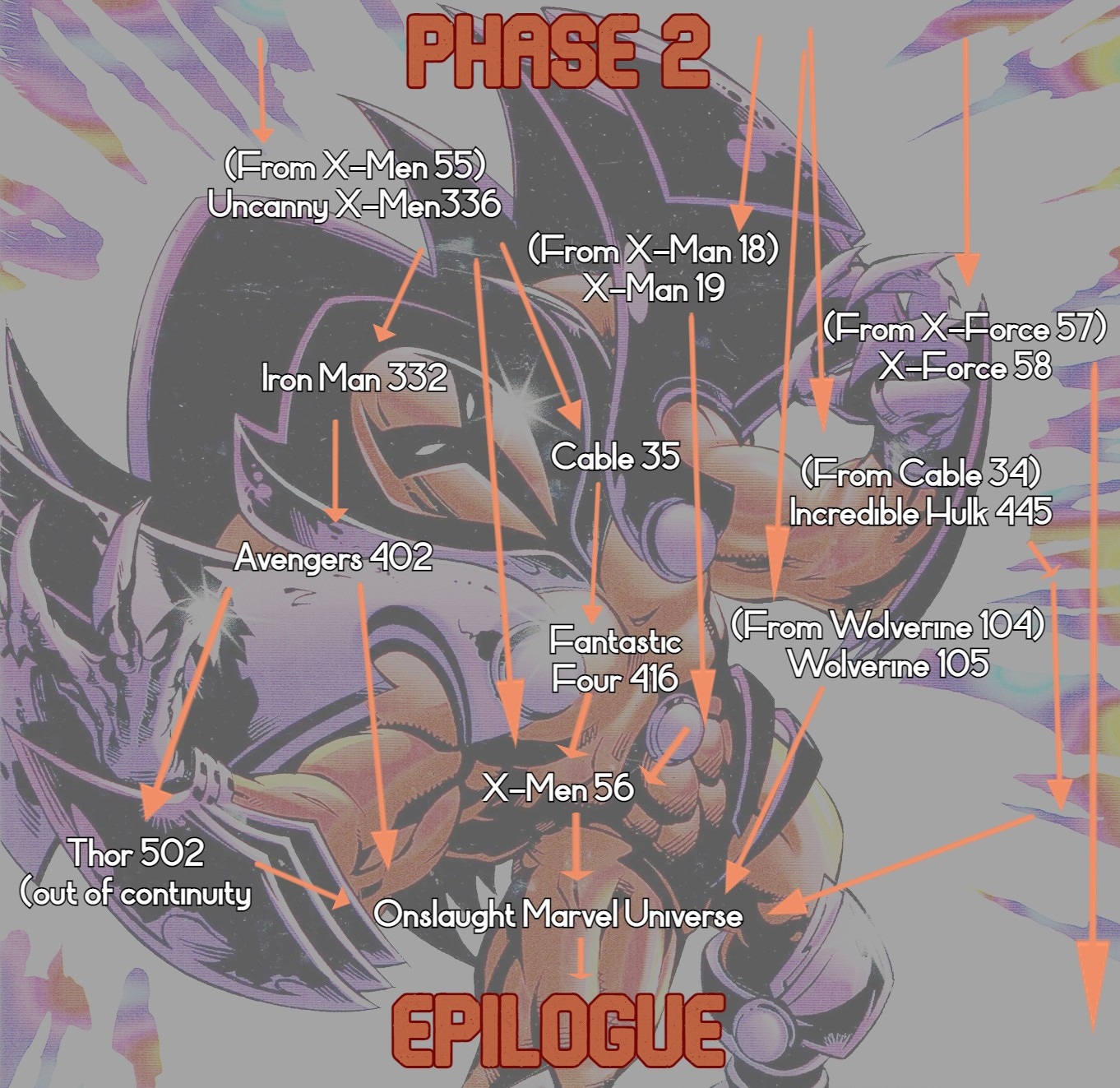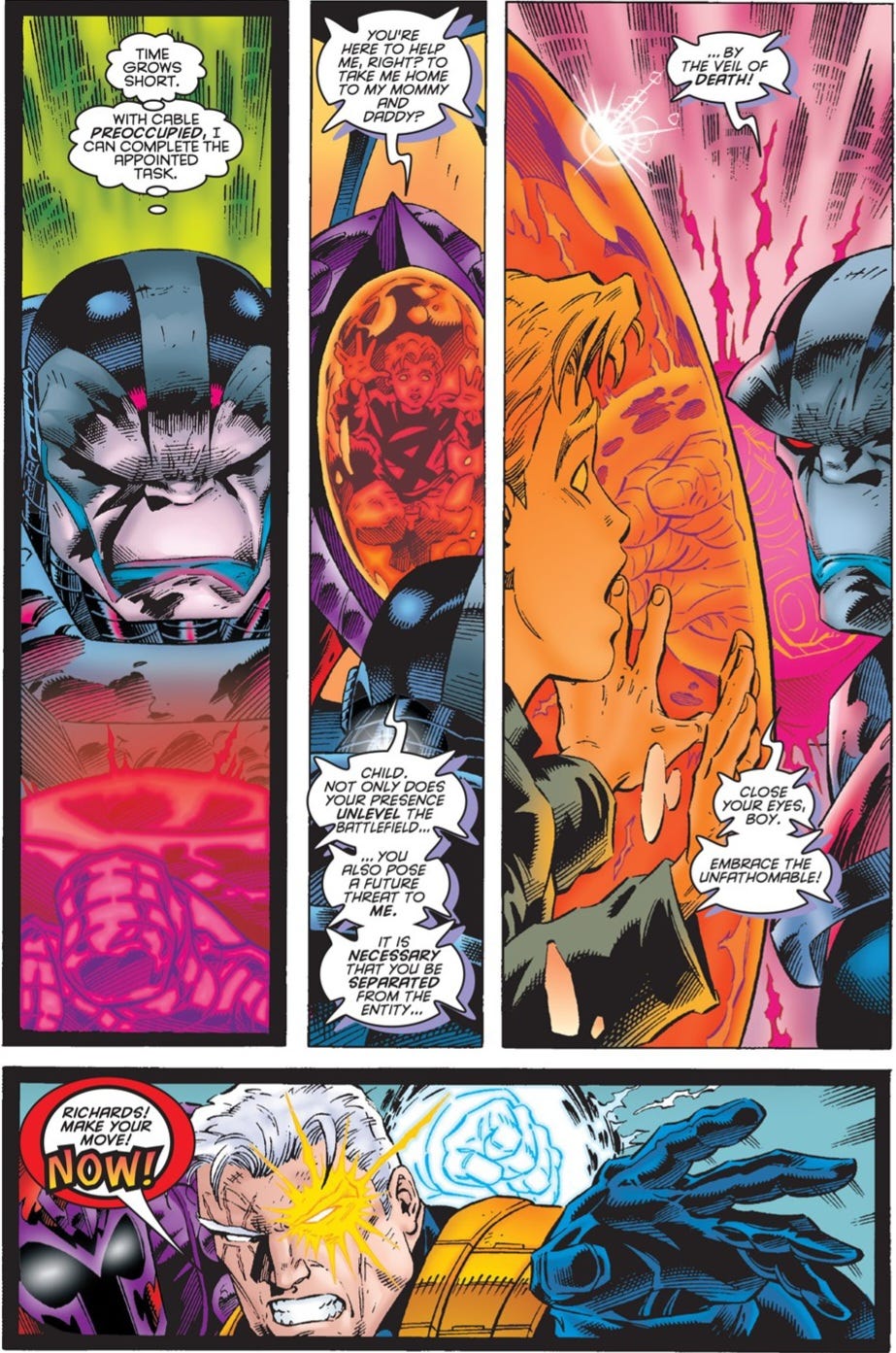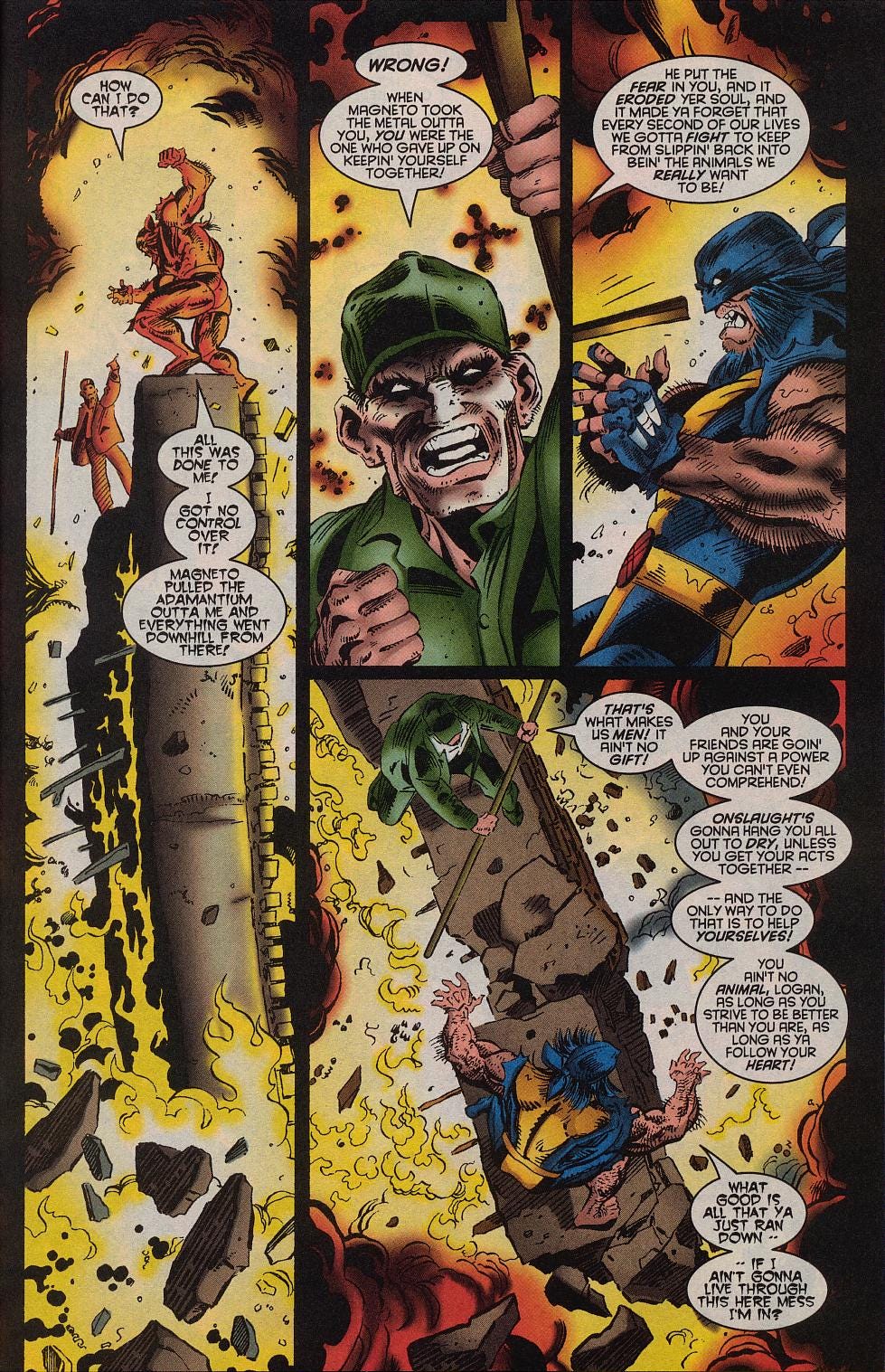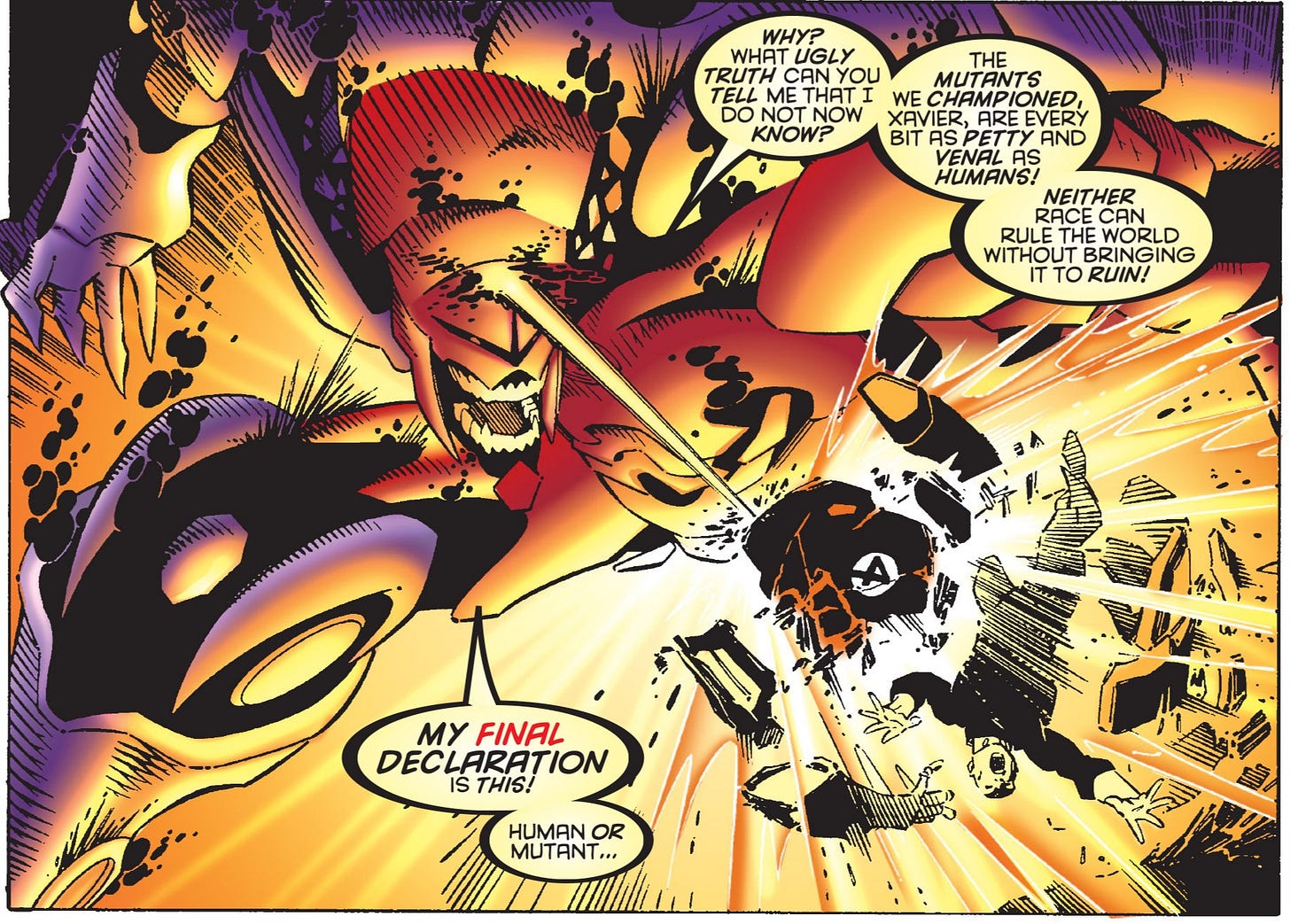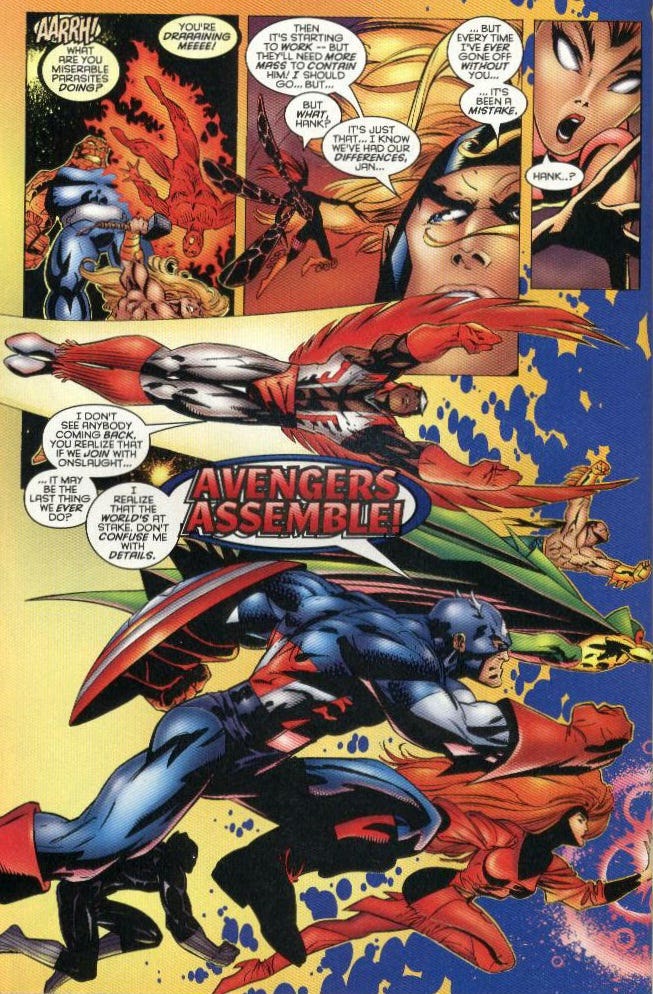Considering its lengthy build up, it’s a surprise that Onslaught only lasted two months. For as big a story as it tried to tell, the event is shockingly short. Even more surprising is that in its second month, only five issues out of nineteen are essential (if we assume phase is primary and impact secondary). For the purposes of this retrospective, though, I moved six issues from the event’s second month to Phase 1 and another issue to the Epilogue in an attempt to establish an ideal continuity. As a result, Phase 2 consists of the following issues (listed in a suggested reading order). Some issues have minor significance while others have none
Eternal Enemies
Uncanny X-Men 336 brings us back to Xavier who remains trapped inside Onslaught (alongside Franklin). Thor eventually rescues Xavier by forcibly ripping him out of Onslaught, but the psionic entity is able to survive without Xavier as a host because he merged the minds of Xavier and Franklin and transformed himself into a higher form. This is inconsistent with X-Men 55 where Onslaught needed Franklin to be proactive to exploit his powers. After Xavier is rescued, Onslaught again unleashes one of his catastrophic psi blasts–this time with the heroes in close proximity to him–and yet, for the sixth time, no one is disabled or even seriously injured.
In the aftermath of this devastating assault that doesn’t devastate, Sue Storm and Cable embark on a mission to rescue Franklin in Cable 35. Apocalypse takes action for the first and only time in the event when he teams up with the two heroes. The mission’s failure is a foregone conclusion because Apocalypse predictably betrays Cable and Sue by trying to kill Franklin. Apocalypse and Cable’s belabored mutual distrust telegraphs the ending making the story feel like an attempt to justify Apocalypse’s inclusion in Onslaught rather than a necessary plot point.
Fluff and Confusion
X-Force 58 is primarily a character piece, though it does include a scene where Onslaught tries to manipulate the team to do an unspecified bad thing that will destroy them only for them to be saved by the psychic projection of Xavier’s innocent youth who praises them for…yeah, none of this makes sense. Incredible Hulk 445 sees Onslaught try to drive a wedge between Hulk and the Avengers by showing the Avengers a scenario Onslaught telepathically created for Hulk. In it Hulk ignores his allies, allowing the Avengers to be killed so he could kill Onslaught. But Peter David’s failure to have any characters react to what they’ve just seen Hulk do tells you exactly how important this issue is.
Meanwhile in the main story (sort of) that psi armor design from Muir Island finally comes into play. In Iron Man Tony uses the design to create psi dampeners to protect against Onslaught. That thread continues into Avengers 402 where Tony catches up with the rest of the team to share his technological bounty. It's strange that after the armor was such a focus in earlier issues, its implementation happens in an offshoot storyline (these are both “impact” issues and seemingly, by the event’s logic, secondary).
Fantastic Four 416 makes absolutely no sense. The team is overrun by phantoms projected by Onslaught and are ultimately saved by heroes arriving randomly in different parts of the building. How these new heroes know about the attack or where they suddenly appear from is not explained. To defeat the phantoms Reed builds a machine that blocks Onslaught's psi projections but immediately says its not actually powerful enough to stop the villain.
Characters Shine
Wolverine 105 and X-Man 19 unintentionally mirror each other with an examination of character choice. Wolverine makes a major turn in his issue when, despite everything that’s happened to him recently (Onslaught takes place on the heels of Wolverine turning feral), he realizes that he still has the ability to choose who and what he is—and he chooses to remain a man. Meanwhile, Nate has a heated discussion with Sinister about Sinister’s never-ending desire to destroy Apocalypse. Nate realizes that since his arrival in the prime universe he’s been at the mercy of people who have been trying to define and manipulate him. Nate finally decides to reject all of that, ignore everyone else’s designs, and be his own man. This is handled really well and is the kind of revelation that can spur serious character growth. Unfortunately this subplot proves meaningless when the Nate/Sinister interaction is interrupted by Onslaught who steals Nate away on the issue’s last page. Neither this arc nor Sinister are mentioned again.
Iron Man 332, Avengers 402, and Thor 502 (which is one big continuity error) are all strange contradictions. These are basically final issues for the characters involved because they will be part of Heroes Reborn, but rather than lean into some kind of finale, each issue provides strong character arcs. I say this is strange because character development will be rendered irrelevant by the Heroes Reborn reboot. Nevertheless, they are enjoyable entries.
A House of Cards Collapses
The event proper wraps up with X-Men 56 and Onslaught Marvel Universe. Onslaught examines Nate's memories of the Age of Apocalypse to determine how that world was conquered by mutants. Apparently Onslaught had no plan to achieve his stated goal (which explains why the motiveless sentinel invasion of New York makes no sense). This creates an indescribably huge plot hole.
Onslaught's reason for kidnapping Nate is to gain this knowledge (though he eventually pays lip service to how valuable Nate's power is). But Onslaught had access to Bishop's fragmented Age of Apocalypse memories as well as long term interactions with Age of Apocalypse natives Holocaust and McCoy. He should have learned everything he needed to know a long time ago and without needing Nate who wasn't even alive during Apocalypse's rise to power.
Then, after learning about the Age of Apocalypse’s dystopian nature and apocalyptic end, Onslaught decides mutants are equally unworthy and announces that he will destroy the planet.
This utter failure in storytelling invalidates everything that came before it. Establishing in the event’s penultimate issue that the villain had no plan of his own to accomplish his goal destroys him as a serious character and tells the reader that the writers never bothered to actually develop him. And having Onslaught make this heel turn to global destruction is entirely inconsistent with his characterization to this point (limited though it is) and reads like a desperate attempt to create a threat big enough to justify the “sacrifice” the heroes make in the final issue. This changes the story into something completely different than what it was when it began and reeks of an editorial contrivance. Readers could be forgiven for skipping from Onslaught X-Men to X-Men 56 because this twist renders everything in between irrelevant.
Onslaught’s final issue, Onslaught Marvel Universe, reads like the editorial device it is. The issue is mostly one long fight sequence. Following up on his intention to destroy Earth, Onslaught uses Franklin’s power to create a second sun to destroy the planet. The heroes throw everything they’ve got at Onslaught, eventually destroying his physical shell (drawn in wildly different proportions throughout the issue ranging from as big as a two story building to as small as the Hulk) which turns him into a being of pure psionic energy with no physical form. So, with no discussion whatsoever, the heroes charge into the energy field to give it mass so that can be attacked. There’s no explanation for how this works, and Onslaught doesn’t look any different as it happens.
Mutants can’t sacrifice themselves because when they make physical contact with Onslaught he grows stronger. This is established earlier when Rogue punches him, but it isn’t explicitly stated at the time and thanks to the inconsistent art Onslaught actually appears smaller after Rogue’s punch. However, Scarlet Witch and Namor are both included in the Heroes Reborn universe so the writers contrive the excuse that Wanda’s hex protected her for reasons unknown (this is established retroactively since we don’t even see Wanda fly into Onslaught)—and as for Namor…well for Namor they don’t even bother with an excuse.
Once the non-mutants have sacrificed themselves, the X-Men attack. Strangely, despite the admonition against mutants coming in contact with Onslaught just a couple pages earlier, both Wolverine and Rogue are depicted as part of that attack. Simultaneous to all of this, Cable and Xavier rescue Nate and Franklin from Onslaught’s tower.
So Onslaught is destroyed and the Avengers, Fantastic Four, and assorted other heroes have been removed from the prime universe. The reader is left to assume the second sun disappeared because after its initial appearance early in the issue (featured in exactly one panel) it is never seen or mentioned again.
The Heroes’ Send-Off
This ending is an absolute mess. Almost every choice the characters make lacks foundation. There’s no consideration that Cable and Jean might be able to attack Onslaught’s psionic form. Franklin and Nate discuss pooling their powers to escape only for that to not be followed up on which leaves them conveniently absent for the final battle. The heroes’ decision to sacrifice themselves reads exactly like the board clearing that it is.
However, despite all the negative criticism I’ve just heaped on the final issues of the event, there are things to like here. The Wolverine and Nate Grey arcs are enjoyable. The long running Joseph guilt and redemption arc is outstanding, and Xavier plays off it to great effect after his rescue. X-Force’s character examination is most welcome for readers of the series. The art, save some problems in Onslaught Marvel Universe, is again outstanding. And fortunately there will be an exceptional epilogue to cleanse the palate.
<— Previous: Onslaught Phase 1
Onslaught is not a well organized event. It’s not linear, moving from one part to another. Nor is it organized around a central series augmented by optional tie-ins…
Next: Onslaught Epilogue —>
Onslaught Marvel Universe tried to end the event with a bang, but the abrupt way everything happens combined with the shallow emotions connected to it really send it out with more of a whimper…
Check out the Introduction for an index of posts. For issue-by-issue commentary of every issue, visit my Twitter @theronscomics #MarvelOnslaught.
Thanks For Reading!
I love making comic book content, but it takes a lot of time. If you’re so inclined, donations make a big difference. And thanks to everyone who has chipped in!
Did you enjoy the post? Feel free to share it!
Want to add to the discussion? Drop a comment! Want reviews and other content straight to your inbox?
If you like my comic content and are into video games, I do walkthroughs with detailed story analysis at Bookishly Gaming.
Find my content all over the internet.



